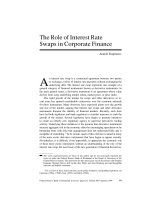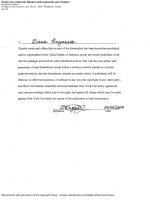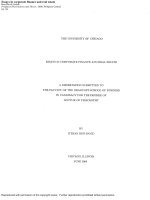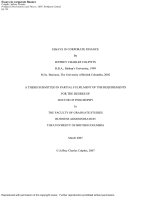Two essays in corporate finance
Bạn đang xem bản rút gọn của tài liệu. Xem và tải ngay bản đầy đủ của tài liệu tại đây (789.4 KB, 157 trang )
TWO ESSAYS IN CORPORATE FINANCE
by
Mehmet Engin Akbulut
A Dissertation Presented to the
FACULTY OF THE GRADUATE SCHOOL
UNIVERSITY OF SOUTHERN CALIFORNIA
In Partial Fulfillment of the
Requirements for the Degree
DOCTOR OF PHILOSOPHY
(BUSINESS ADMINISTRATION)
August 2006
Copyright 2006 Mehmet Engin Akbulut
UMI Number: 3238329
3238329
2007
UMI Microform
Copyright
All rights reserved. This microform edition is protected against
unauthorized copying under Title 17, United States Code.
ProQuest Information and Learning Company
300 North Zeeb Road
P.O. Box 1346
Ann Arbor, MI 48106-1346
by ProQuest Information and Learning Company.
ii
Dedication
For Arif and Havva Akbulut,
For Rahşan and Hakan Akbulut
iii
Acknowledgements
First and foremost, I would like to thank my advisor, John Matsusaka, for
his constant support, encouragement and motivation during my Ph.D. years. He
spent numerous hours in reading my work and guiding me to become a good
scholar. I have learned a lot from him and constantly benefited from his valuable
comments and suggestions. I am truly indebted to him.
I am greatly indebted to my dissertation committee members, Harry
DeAngelo and Kevin Murphy for their numerous suggestions and expert
guidance. I thank Pedro Matos, Lior Menzly, Micah Officer, Oğuzhan Özbaş and
Şelale Tüzel, for many stimulating discussions and suggestions throughout my
writing of the dissertation. I thank Ayşe and Selahattin İmrohoroğlu for their
friendship and support which started from the very first moment I decided to
apply to the Ph.D. program and grew ever since. I thank my fellow classmates
Qing Ma and Jianfei Sun for enduring this journey with me and for their empathy
and support along the way.
One unexpected side benefit of the years I spent as a Ph.D. student is that I
made life long friends; Murat, Banu and Sinan Birdal and Şelale and Murat Bayız,
whose love, empathy and humor lightened even the darkest of moods and gave
me strength to move forward. I consider myself very lucky to have met them and
thank them for being with me along the way.
iv
I thank my father and mother; Arif and Havva Akbulut and my sisters;
Rengin and Pelin. There was not a single moment during this time that I did not
feel their generous love, understanding, and unwavering support behind me, from
thousands of miles away. Their patience had been remarkable, their sacrifice
tremendous, and I am glad I was able to make them proud in the end. Finally, I
would like to thank my wife Rahşan, for her endless love, patience and
unwavering support for all those years. None of this would be possible if it was
not for her.
v
Table of Contents
Dedication ii
Acknowledgements iii
List of Tables vii
List of Figures x
Abstract xii
Chapter 1: Managerial Insider Trading and Opportunism 1
1.1 Introduction 1
1.2 Method and Data 4
1.2.1 Measures of Insider Trading 4
1.2.2 Insider Trading Sample 6
1.2.3 Acquisition Sample 8
1.2.4 Seasoned Equity Offerings Sample 10
1.2.5 Share Repurchase Sample 11
1.2.6 Mean and Median Managerial Trading
Around Events 12
1.3 Managerial Opportunism and Abnormal Trading 20
1.3.1 Measuring Abnormal Trading 20
1.3.2 Non-Informational Motives for Trading 21
1.4 Managerial Trading around Stock and Cash
Acquisitions, SEOs and Share Repurchases 23
1.4.1 Stock Acquisitions versus Cash Acquisitions 25
1.4.2 SEOs and Share Repurchases 34
1.5 Running for the Exits 41
1.6 Discussion 56
1.7 Conclusion 58
Chapter 2: Market Misvaluation and Merger Activity:
What do Managers’ Insider Trades Tell Us? 60
2.1 Introduction 60
2.2 Data and Method 69
2.2.1 Sample Description 69
2.2 Measuring Overvaluation 79
2.3 Empirical Predictions of the Market Misvaluation
Theory 83
vi
2.4 Univariate Tests 87
2.5 Multivariate Tests 96
2.5.1 Acquisition and Method of Payment decision 96
2.5.2 Acquirer and Target Announcement Returns 106
2.5.3 Long-Run Abnormal Returns 114
2.5.3.1 Buy-and-Hold Abnormal Returns 114
2.5.3.2 Calendar Time Portfolio Regressions 118
2.5.3.3 Calendar Time Abnormal Returns 121
2.6 More Comprehensive Measures of Trading 124
2.7 Overview of the Main Findings 132
2.8 Conclusion 137
Bibliography 139
vii
List of Tables
Table 1.1: Insider Trading Sample 7
Table 1.2: Acquisitions Sample 9
Table 1.3: Seasoned Equity Offerings Sample 11
Table 1.4: Share Repurchases Sample 12
Table 1.5: Trading Activity for manager-years with and
without Stock and Cash Acquisitions 14
Table 1.6: Trading Activity for manager-years with and
without SEOs and Share Repurchases 17
Table 1.7: Abnormal Trading Activity around Stock and
Cash Acquisitions using NETPR and CHNG
26
Table 1.8: Abnormal Trading Activity around Stock and
Cash Acquisitions using NETDLR and CHNGDLR 29
Table 1.9: Abnormal Trading Activity around Stock and
Cash Acquisitions using NETSHROUT and
CHNGSHROUT 32
Table 1.10: Abnormal Trading Activity around SEOs and
Share Repurchases using NETPR and CHNG 34
Table 1.11: Abnormal Trading Activity around SEOs and
Share Repurchases using NETDLR and CHNGDLR
37
Table 1.12: Abnormal Trading Activity around SEOs and
Share Repurchases using NETSHROUT and
CHNGSHROUT 39
Table 1.13: Changes in managerial holdings for the bottom 5%
of the sample sorted by CHNG 50
Table 1.14: Running for the Exits - Stock and Cash Acquisitions
51
viii
Table 1.15: Running for the Exits - SEOs and Share Repurchases
54
Table 2.1: Descriptive Statistics – Merger Data 71
Table 2.2: Descriptive Statistics - Insider Trading Data 77
Table 2.3: Mean Acquirer and Target Managerial Trading Activity
in the one-year period before the Merger 88
Table 2.4: Mean acquisition characteristics sorted by acquirer’s
pre-merger managerial trading activity 90
Table 2.5: Mean acquisition characteristics sorted by target’s
pre-merger managerial trading activity 94
Table 2.6: Logistic regression estimates of the likelihood of
becoming an acquirer in the current quarter
98
Table 2.7: Logistic regression estimates of the likelihood of
becoming a target firm in the current quarter
103
Table 2.8: Ordinary least squares estimates of the relation between
prior net purchases of acquirer managers and acquirer’s
merger announcement return 107
Table 2.9: Ordinary least squares estimates of the relation between
prior net purchases of target managers and the target’s
merger announcement return
112
Table 2.10: Acquirer’s post-merger Buy-and-Hold Abnormal
Returns (BHARs)
116
Table 2.11: Acquirer’s post-merger Abnormal Returns using
Calendar Time Portfolio Regressions (CTPR) Method 119
Table 2.12: Acquirer’s post-merger Abnormal Returns using
Calendar Time Abnormal Returns (CTAR) Method
122
Table 2.13: Logistic regression estimates of the likelihood of
becoming an acquirer firm in the current quarter
127
ix
Table 2.14: Ordinary least squares estimates of the relation
between NETPR, CHNG and acquirer’s merger
announcement return
130
Table 2.15: Acquirer’s post-merger Abnormal Returns using
Calendar Time Abnormal Returns and NETPR
133
Table 2.16: Acquirer’s post-merger Abnormal Returns using
Calendar Time Abnormal Returns and CHNG
135
x
List of Figures
Figure 1.1: Distribution of NETPR for manager-years with only
stock acquisitions and for manager-years with no
acquisitions 42
Figure 1.2: Distribution of CHNG for manager-years with only
stock acquisitions and for manager-years with no
acquisitions 43
Figure 1.3: Distribution of NETPR for manager-years with only
cash acquisitions and for manager-years with no
acquisitions 43
Figure 1.4: Distribution of CHNG for manager-years with only
cash acquisitions and for manager-years with no
acquisitions 44
Figure 1.5: Distribution of NETPR for manager-years with only
stock acquisitions and for manager-years with only
cash acquisitions 44
Figure 1.6: Distribution of CHNG for manager-years with only
stock acquisitions and for manager-years with only
cash acquisitions 45
Figure 1.7: Distribution of NETPR for manager-years with only
SEOs and for manager-years with no SEOs or share
repurchases 46
Figure 1.8: Distribution of CHNG for manager-years with only
SEOs and for manager-years with no SEOs or share
repurchases 46
Figure 1.9: Distribution of NETPR for manager-years with only
share repurchases and for manager-years with no SEOs
or share repurchases 47
Figure 1.10: Distribution of CHNG for manager-years with only
share repurchases and for manager-years with no SEOs
or share repurchases 47
xi
Figure 1.11: Distribution of NETPR for manager-years with only
SEOs and for manager-years with only share
repurchases 48
Figure 1.12: Distribution of CHNG for manager-years with only
SEOs and for manager-years with only share
repurchases 48
Figure 2.1: Annual Frequency of Mergers by Method of Payment 73
Figure 2.2: Percentage of CRSP Market Capitalization Acquired 74
xii
Abstract
The first paper of this dissertation examines whether managers engage in
opportunistic insider trading by measuring how their net open market purchases
and holdings of own company stock change around acquisitions, seasoned equity
offerings and share repurchases after controlling for their share and option
holdings and non-informational motives for trading. On average, managers
abnormally increase sales and reduce holdings around stock acquisitions and
seasoned equity offerings but not around cash acquisitions and share repurchases.
However the typical manager does not experience an economically significant
change in ownership; more material ownership changes are limited to the subsets
of the sample. These results suggest that the evidence for managerial opportunism
is modest in magnitude and not pervasive in the sample.
The second paper of this dissertation explores the link between stock
market overvaluation and merger activity. I examine how managers recently
traded in own company stock in their personal portfolios to infer whether they
view their firm as overvalued or undervalued. I find that firms whose managers
sold more recently are more likely to acquire other firms for stock and the
subsequent mergers have negative and lower short-run and long-run abnormal
returns. However using measures which express trading as a percentage of share
and option holdings and as changes in ownership, these results weaken
considerably. Hence my findings show that the predictions of market
xiii
misvaluation theory are weakly supported at best, if supported at all, by the data at
hand.
1
Chapter 1
Managerial Insider Trading and Opportunism
1.1 Introduction
Insider trading receives a substantial amount of attention from the
investors, the government and the academicians alike. This is not surprising;
given insider trading is widely regarded as reflecting the superior information of
the insiders about the firm. Investors follow it closely hoping to earn abnormal
profits. Government scrutinizes it vigorously to detect the illegal use of inside
information. Academicians use it to understand the extent of informational
asymmetries between the insiders and the market.
Of particular interest to academicians is the insider trades made by the
managers. For example, many studies measure the information advantage of
managers by calculating the abnormal changes in stock prices following
managerial insider trades.
1
Others try to understand the managerial motives
behind important corporate events like mergers, restructurings and stock issuances
by examining the abnormal changes in managerial trading patterns prior to the
1
See Jaffe (1974), Finnerty (1976), Seyhun (1986, 1988), Rozeff and Zaman (1988), Lin and
Howe (1990), Jeng, Metrick and Zeckhauser (1999).
2
announcement of such plans.
2
Insider trades provide a unique insight into the
minds of managers whose very actions create or destroy firm value.
This paper aims to understand whether managers opportunistically use
private information in their insider trades after controlling for their share and
option holdings and non-informational motives for trading. I look at how
managers trade and change their holdings of own company stock in years when
there are stock acquisitions, seasoned equity offerings (SEOs) and share
repurchases. Stock acquisition and SEO announcements may signal to the market
that managers think the firm is overvalued
3
, while share repurchases may signal
the market that managers think the firm is undervalued. Indeed stock acquisitions
4
and seasoned equity offerings
5
tend to cluster in times of high stock market
valuations, whereas share repurchases
6
are more common in times of low market
valuations. If managers are indeed timing the market in their corporate finance
decisions by issuing stock when it is overvalued and repurchasing it when it is
undervalued, they should do the same with their own money. Acting on their
private information, they should decrease their holdings of company stock in
2
Seyhun (1990b) finds increased purchases and no significant changes in sales prior to mergers
and tender offers. Lee et al. (1992) find increased purchases and reduced sales prior to repurchase
tender offers. Karpoff and Lee (1991) find increased sales prior to seasoned offerings of common
stock.
3
If managers have more information about the true value of the firm than the market, they will
want to issue new equity when they think that their stock is overvalued (Myers and Majluf, 1984).
4
See Nelson (1959) , Andrade et al. (2001)
5
See Taggart (1977), Marsh (1982), Jung, Kim and Stulz (1996), and Hovakimian, Opler and
Titman (2001).
6
See Ikenberry, Lakonishok, and Vermaelen (1995).
3
years when there is a stock acquisition or an SEO, while they should increase
their holdings in years when there is a share repurchase. My findings point to a
two-sided story: On one hand, I find that managers decrease their holdings by 8.5
percent or 7 million dollars in years when there is at least one stock acquisition,
by 10 percent or 3.6 million dollars when there is at least one SEO, while they
increase their holdings by 7 percent or 2 million dollars in years when there is at
least one share repurchase. The percentage of managers who decrease their
holdings by 35 percent or more almost doubles in years when there are only stock
acquisitions or SEOs, does not change in years when there are only cash
acquisitions and almost halves in years when there are only share repurchases.
The distributions of net purchases and changes in holdings shift to the left when
there is a stock acquisition or an SEO, does not change when there is a cash
acquisition and shift to the right when there is a share repurchase. On the other
hand, looking at the absolute changes in holdings reveals that the typical manager
experiences a small ownership change, whereas more material ownership changes
are limited to the subsets of the sample. For example the median manager-year
with only stock acquisitions sees a decrease in holdings of only 1 percent or
$100,000, which is driven mainly by manager-years with only multiple stock
acquisitions. These results suggest that the evidence for managerial opportunism
is modest in magnitude and not pervasive in the sample.
4
1.2 Method and Data
1.2.1 Measures of Insider Trading
There are many insider trading measures used in the literature. For
example Seyhun (1990) uses number and dollar value of shares purchased and
sold to examine managerial insider trading around acquisitions, Lee (1992) uses
the percentage of net buyer managers and net seller managers to examine trading
before repurchases, Lee (1997) uses pure seller and pure buyer measures to
examine trading before equity issues, John and Lang (1991) use aggregate number
of insider purchase and sale transactions to examine trading around dividend
announcements. However none of these measures control for the existing share
and option holdings of the manager. Expressing trading as a percentage of share
and option holdings will paint a better picture of the economic meaning and
significance of those trades for the manager. I use two alternative measures of
insider trading activity.
7
The first measure is net open market purchase as a percentage of
beginning of the year share and option holdings (NETPR):
NETPR=
t
holdings)option Beginning holdings share Beginning(
t
Sales)Market Open -PurchasesMarket (Open
+
7
I thank Kevin Murphy for suggesting these measures.
5
The second measure is annual percentage change in total holdings (CHNG):
CHNG=
t
holdings)option Beginning holdings share Beginning(
t
holdings)Option (
t
holdings) (Share
+
∆+∆
All purchases, sales, share and option holdings are measured in terms of split-
adjusted number of shares.
8
Measuring trading and change in holdings as a
percentage of share and option holdings enables me to capture the economic
significance of those trades. In order to ensure that results are not driven by
outliers, both NETPR and CHNG are set to fall in between -100 percent and 200
percent levels.
9
In order to check the robustness of my findings and to better understand
the economic significance of managerial trades, I also calculate the dollar value of
net open market purchases (NETDLR) and change in holdings (CHNGDLR) as
well as net open market purchases as a percentage of shares outstanding at the end
of the year (NETSHROUT) and change in holdings as a percentage of shares
outstanding at the end of the year (CHNGSHROUT) as follows:
NETDLR= (Open Market Purchases – Open Market Sales)
t
x (Stock price at the
end of fiscal year)
t
CHNGDLR= (
tt
holdings)Option (holdings) (Share
∆
+
∆ ) x (Stock price at the
end of fiscal year)
t
8
Results are robust to using dollar values rather than number of shares.
9
Results are robust to winsorizing at 1 percent instead.
6
NETSHROUT=
t
year) fiscal of end at the gOutstandin Shares ofNumber (
t
Sales)Market Open -PurchasesMarket (Open
CHNGSHROUT=
t
tt
year) fiscal of end at the gOutstandin Shares ofNumber (
holdings)Option (holdings) Share(
∆
+
∆
NETDLR and CHNGDLR make it easier to see the economic magnitude and
importance of trades whereas NETSHROUT and CHNGSHROUT go one step
further by explicitly controlling for firm size. Finally, in order to make sure my
results are not driven by outliers, I winsorize these variables at the one percent
level.
1.2.2 Insider Trading Sample
The insider trading sample is from Compustat’s Executive Compensation
Database (Execucomp). Execucomp is an annual database which reports manager-
level information on managerial equity ownership, option holdings, equity grants
and option grants, and option exercises starting from 1992 for the five highest
paid executives in the S&P 500, the S&P MidCap 400, and the S&P SmallCap
firms. However it does not report open market purchases and sales directly.
Following Jenter (2005), I calculate net open market purchase for a manager in
year t as follows:
t
granted Shares
t
granted Options
t
holdings)Option (
t
holdings) Share( −
−
∆+∆
7
This approach requires taking first differences; therefore a manager needs to be
present in the database for at least two consecutive years to be included in the
sample.
Table 1.1 lists the Execucomp Sample. There are 2,014 firms, 12,626
firm-managers and 38,304 firm-manager-years from 1993 to 2000. Managers are
net sellers on the open market on average during this period; NETPR has a mean
of -7 percent and median of -4 percent. This corresponds to a mean net selling of
6.4 million dollars and a median net selling of 0.3 million dollars for the 1993-
2000 period. Despite this, their total holdings grow at an average rate of 15
percent for the same period due to option and stock grants awarded.
Table 1.1: Insider Trading Sample
Panel A:
Number of NETPR CHNG
Number of Number of Manager (%) (%)
Year Firms Managers Years
Mean Median Mean Median
1993
1,005 3,843 3,882
-6 -4 14 5
1994
1,255 5,068 5,113
-6 -2 15 7
1995
1,332 5,344 5,380
-7 -3 13 5
1996
1,389 5,554 5,578
-6 -3 16 7
1997
1,394 5,565 5,577
-8 -5 15 6
1998
1,436 5,732 5,768
-9 -4 16 8
1999
1,486 5,907 5,931
-7 -3 18 9
2000
275 1,075 1,075
-8 -4 16 7
1993-2000
2,014 12,626 38,304
-7 -4 15 7
8
Table 1.1 (Continued)
Panel B:
NETDLR CHNGDLR NETSHROUT CHNGSHROUT
($ millions) ($ millions) (%) (%)
Year
Mean Median Mean Median Mean Median Mean Median
1993 -5.7 -0.3 -1.1 0.2 -0.0013 -0.0001 -0.0003 0.0001
1994 -5.4 -0.1 -0.9 0.3 -0.0011 -0.0001 -0.0001 0.0001
1995 -5.9 -0.2 -1.3 0.2 -0.0015 -0.0001 -0.0004 0.0001
1996 -6.1 -0.2 -0.8 0.3 -0.0013 -0.0001 -0.0001 0.0002
1997 -6.6 -0.4 -0.8 0.3 -0.0016 -0.0002 -0.0002 0.0002
1998 -7.4 -0.4 -1.5 0.4 -0.0016 -0.0002 -0.0001 0.0002
1999 -6.5 -0.2 -0.7 0.5 -0.0014 -0.0001 0.0002 0.0003
2000 -9.2 -0.3 -2.3 0.3 -0.0017 -0.0002 0.0000 0.0003
1993-2000 -6.4 -0.3 -1.0 0.3 -0.0014 -0.0001 -0.0001 0.0002
Next I create event samples and merge them with the insider trading
sample in order to examine the insider trading activity around these events.
1.2.3 Acquisition Sample
I searched the Securities Data Corporation (SDC) Platinum Mergers &
Acquisitions database for completed acquisitions of domestic and foreign public,
private and subsidiary companies by U.S. public acquirers from January 1993 to
December 2000 where:
•
Data on method of payment and deal value is available.
•
Deal Value is at least 1 percent of acquirer’s market value at day -3 relative to
the announcement day.
•
There is price and return data for the acquirer firm in the University of
Chicago’s Center for Research in Security Prices (CRSP) database.
9
•
Insider Trading Data is available.
These requirements result in 4,040 usable observations. Table 1.2 shows
the descriptive statistics. Median deal value is $120 million and median relative
deal value is 6 percent indicating that these acquisitions represent economically
significant investments for the acquirers. Acquisitions are evenly split between
public, private and subsidiary targets, although in 1999, the peak of the dot.com
merger wave we see that the majority of the deals involve public targets. Method
of payment is mostly pure cash.
Table 1.2: Acquisitions Sample
Number of Deal Value Acquirer's Market Relative Size
Acquisitions ($ Millions) Value ($ Millions) of the Deal (%)
Year
N Mean Median Mean Median Mean Median
1993 370 229 73 3,117 1,433 11 5
1994 451 291 91 3,345 1,407 14 5
1995 548 536 93 3,815 1,523 15 5
1996 589 666 116 3,939 1,707 18 6
1997 626 651 152 5,576 1,869 18 6
1998 699 1,345 147 6,500 2,217 18 6
1999 641 1,039 153 10,396 1,992 17 5
2000 116 2,827 149 22,110 1,872 14 5
1993-2000 4,040 803 120 6,023 1,736 16 6
10
Table 1.2 (Continued)
Number of
Acquisitions Method of Payment (%) Target Type (%)
Year
N
Pure
Stock
Pure
Cash Mixed Private Public Subsidiary
1993
370
31 51 18 33 28 39
1994 451 29 53 19 32 33 35
1995 548 31 52 17 32 36 32
1996 589 28 51 21 32 32 35
1997 626 31 48 21 31 36 33
1998 699 29 48 23 33 36 31
1999 641 25 51 24 31 40 29
2000 116 32 47 22 41 31 28
1993-2000 4,040 29 50 21 32 35 33
1.2.4 Seasoned Equity Offerings Sample
I obtained the list of completed SEOs by U.S. companies from January
1993 to December 2000 from SDC Database using the following criteria from
Kahle (2000) and Lee (1997):
•
At least 50 percent of the offering must be newly issued primary shares.
•
The security issue is not a combination of different classes of securities.
•
The issue is not a shelf registration or rights offering.
•
The security is not an REIT (SIC 6798) or closed-end mutual fund (SIC 6720–
6739).
•
Utilities (SIC codes 4910-4949) are excluded.
•
Price and return data is available in CRSP.
11
•
Insider Trading Data is available.
These requirements result in 191 usable observations. Table 1.3 shows the
descriptive statistics for these 191 SEOs. Median proceeds for the entire 1993-
2000 period is $126 million and median relative value of proceeds is 9 percent
indicating the firms in the sample raised significant amounts from SEOs.
Table 1.3: Seasoned Equity Offerings Sample
Relative Size Offering Firm's
Number o
f
Proceeds of the Offering Market Value
SEOs ($ Millions) (%) ($ Millions)
Year
N Mean Median Mean Median Mean Median
1993 39 265 123 13 11 2,489 1,305
1994 21 174 89 11 10 9,297 1,126
1995 25 189 138 8 7 6,463 1,997
1996 35 210 103 14 10 2,617 1,090
1997 27 152 111 9 8 1,861 1,446
1998 14 317 165 9 8 10,069 2,122
1999 20 394 185 9 5 13,501 2,603
2000 10 201 119 11 12 4,610 1,356
1993-2000
191 233 126 11 9 5,690 1,499
1.2.5 Share Repurchase Sample
I obtained the list of completed share repurchases by U.S. companies from
January 1993 to December 2000 from SDC Database using the following criteria:
•
Amount paid for repurchased shares must be at least 1 percent of repurchasing
firm’s market value at day -3 relative to the announcement day.









